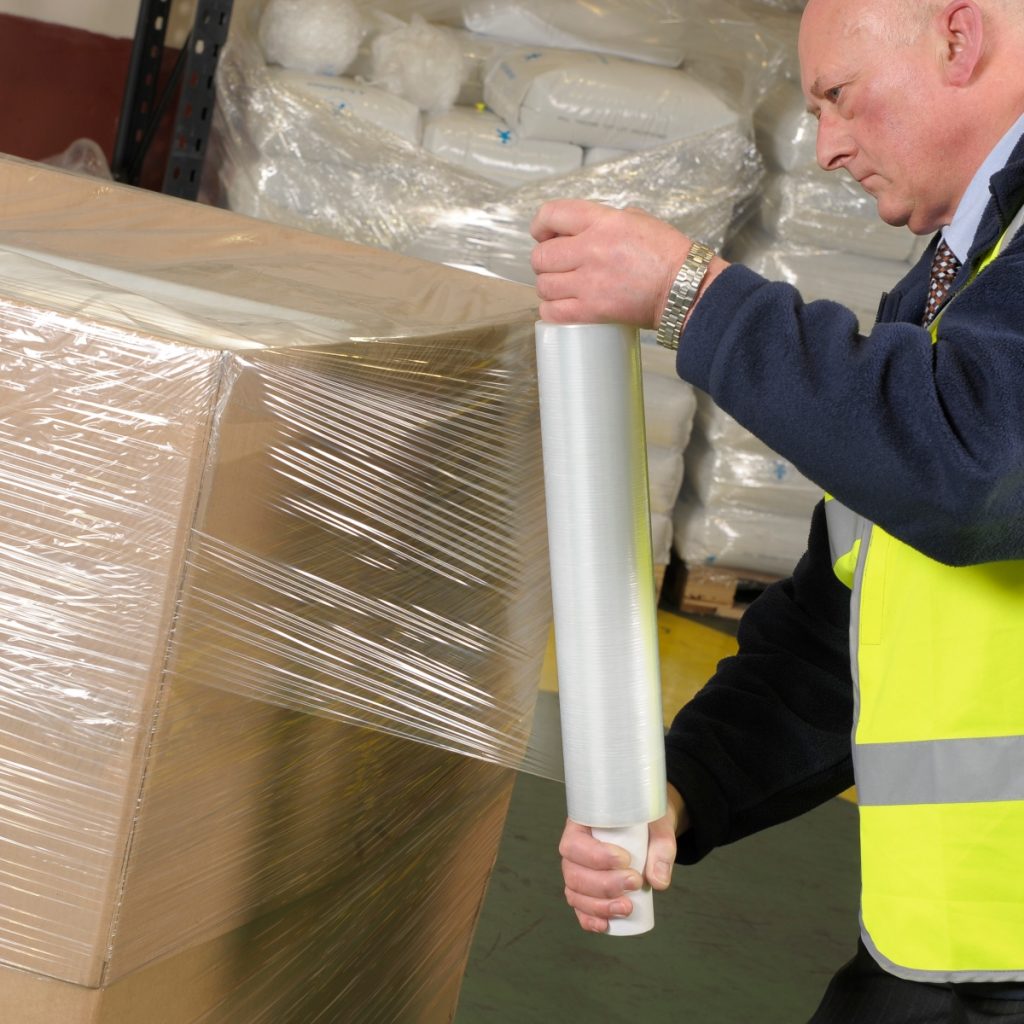Everything You Need to Know About Stretch Wrap: Keep Products Tight in Transit
For any organization that’s in the business of manufacturing, the most crucial part of getting their finished goods into customer hands is getting them off the factory floor, out of the warehouse, and safely out the door. Safely being the operative word.
From the production line to the checkout line, there’s a smorgasbord of events waiting to happen to keep customers from getting those goods, safely: products sliding off of pallets, thumps and bumps in transit, exposure to short bursts of rain or prolonged periods of sun. And the list goes on and on.

There is, however, one surprisingly simple, but perfectly effective material that manufacturers, transporters, and retailers – both big and small – all use in their search for safe handling. No, it’s not terribly different from the same material that’s used in kitchens everywhere.
The perfect wrap
Relied upon throughout the entire supply chain to keep small and large materials in line and intact, linear low-density polyethylene (LLDPE) pallet wrap in a range of lengths and thicknesses is employed to protect those materials from unintentional damage. It’s also of use when it comes to providing protection from very deliberate occurrences of tampering or theft.
The truth is, unless you’re a regular big-box store shopper, or work in a warehouse, then you’re probably not accustomed to seeing too much stretch wrap. But don’t let its apparent absence fool you. Whether it’s been applied with a hand dispenser or by a wrapping machine, it’s not too much of a stretch (no pun intended) to say that stretch wrap is absolutely essential to ensuring that anything that reaches consumers does so as efficiently as possible. And with that in mind, let’s take a look at what this wrap is, where and how it’s used, and what that all really means.
Flexible films
For heavy duty manufacturing, packaging, and warehouse usage there are two types of pallet wrap film available, each with their own set of advantages. Both come in clear or black, and both have the added benefit of being 100% recyclable. They are cast and blown.
Cast film
Manufactured using the less expensive rolled extrusion process, cast films are commonly available in roll lengths between 350m and 520m for handheld dispensers, and roll lengths between 1300m and 1900m for machine wrappers.
The strength, cling, and tear resistance qualities of cast films can be varied according to their micron thickness with 17 and 20 microns being ideal for general usage, while 23 and 25 microns are better for greater durability. Most notably, cast films possess excellent clarity and unwind quietly, making them preferential for:

- Facilities where items need to be rapidly identified; Items that require frequent wrapping and unwrapping;
- Partial or temporary consolidation of items together;
- Maximized inventorying of like-sized items;
- Transporting small, or lightweight items;
- Bonding groups of dull-edged items together; and,
- Short and medium-term storage, or warehousing.
Blown film
Manufactured using the more intensive but more durable blown extrusion process, blown films possess greater stretch properties and stretch memory, as well as higher tear resistance than cast films. Available exclusively in 375m and 400m length rolls for handheld dispensers, and 1200m and 1500m length rolls for machine wrappers, blown films are also noisier to unwind and more opaque than cast films. However, their added toughness makes them ideal for:
- Facilities where rough or questionable handling may occur;
- Consolidating heavy, bulky, or sharp-edged items together;
- All manners of long distance transport;
- Medium and long-term storage, or warehousing;
- Protecting items that may be prone to damage from UV exposure.
There’s also a third pallet stretch wrap option: Eco Stretchwrap. With the advantage of 100% biodegradability over 100% recyclability, this film is available in 300m hand-dispensed and 1500m machine-dispensed lengths and offers all the protective properties of the main types. With the added benefit that it’s use doesn’t impose an undue burden on the environment.
Wrapped to perfection
There are a million practical uses for stretch wrap – at home and at work – but it’s the high volume manufacturing, shipping and warehousing environments where stretch wrapping materials really come into their own.

As a tool of efficient material management, this wrap is used to make commonly palletized items – boxes, bulk bags, and even barrels – easier to handle, as well as less prone to shifting or becoming dislodged during warehousing or shipping. These dimensionally convenient, pallet-sized commodities aren’t exclusive, however, when it comes to benefiting from being stretch wrapped. Irregularly shaped items like furniture, tires and even the root balls of trees are regularly stretch-wrapped prior to transport or storage.
It’s in this simplest context that stretch wrap is practically irreplaceable in production, warehousing and transport environments; but there’s another, incalculable benefit that comes with it as well. Materials that have been stretch wrapped together behave more predictably, making them less likely to cause injuries due to precarious storage or unexpected movement. Stretch eliminates many of the obstacles that every business hopes to avoid.
A final word
At the end of the day, there’s an excellent likelihood that everything in your home or place of work was, at some point, stretch wrapped long before it arrived at its final destination. It shows, however, that the uses for pallet wrap are virtually unlimited, regardless of the application.
If you’re a business owner, there’s a great chance that you’ve stored some material or capital equipment away that could be wrapped to prevent unnecessary loss or damage. If you’re a homeowner, there’s an even better chance that you’ve packed some items away that could benefit from being wrapped to protect them better from excess dust and dirt. If either of these are true, consider purchasing a roll of stretch wrap and a handheld stretcher and see for yourself just what a difference it could make for you.




